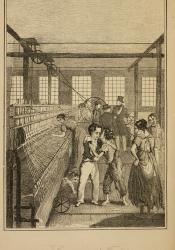The Industrial Revolution and Child Labor
Child labour was not an invention of the Industrial Revolution. Poor children have always started work as soon as their parents could find employment for them. But in much of pre-industrial Britain, there simply was not very much work available for children. This changed with industrialisation. The new factories and mines were hungry for workers and required the execution of simple tasks that could easily be performed by children. The result was a surge in child labour – presenting a new kind of problem that Victorian society had to tackle.
Research has shown that the average age at which children started work in early 19th-century Britain was 10 years old, but that this varied widely between regions. In industrial areas, children started work on average at eight and a half years old. Most of these young workers entered the factories as piecers, standing at the spinning machines repairing breaks in the thread. A few started as scavengers, crawling beneath the machinery to clear it of dirt, dust or anything else that might disturb the mechanism. In the mines, children usually started by minding the trap doors, picking out coals at the pit mouth, or by carrying picks for the miners. As work was often scarce in the country, rural children tended to start work later – typically at 10 and a half years old. Their work consisted of bird-scaring, sowing crops and driving horses. In towns, most boys were employed as errand boys or chimney sweeps, though once again finding employers who wanted to hire a child could be a difficult task. The average age for starting work was 11 and a half years old. There was, therefore, considerable variety in the age at which children started work, with those in the industrial districts typically starting work the youngest. All children laboured under the same disadvantages, though, working for very low pay, performing work that was dirty and dangerous, and usually working long hours as well.

